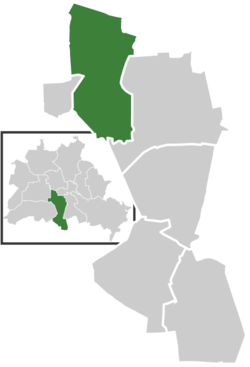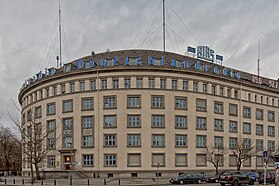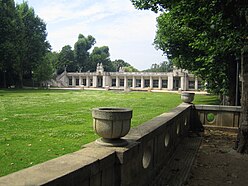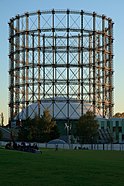Schöneberg
This article needs additional citations for verification. (December 2012) |
Schöneberg | |
|---|---|
 | |
| Coordinates: 52°29′10″N 13°21′20″E / 52.48611°N 13.35556°E | |
| Country | Germany |
| State | Berlin |
| City | Berlin |
| Borough | Tempelhof-Schöneberg |
| Founded | 1264 |
| Area | |
| • Total | 10.6 km2 (4.1 sq mi) |
| Elevation | 50 m (160 ft) |
| Population (2020-12-31)[1] | |
| • Total | 122,658 |
| • Density | 12,000/km2 (30,000/sq mi) |
| Time zone | UTC+01:00 (CET) |
| • Summer (DST) | UTC+02:00 (CEST) |
| Postal codes | (nr. 0701) 10777, 10779, 10781, 10783, 10787, 10789, 10823, 10825, 10827, 10829, 12157, 12159, 12161, 12169 |
| Vehicle registration | B |
Schöneberg (German:
History

The village was first documented in a 1264 deed issued by
Both Alt-Schöneberg and Neu-Schöneberg were in an area developed in the course of industrialization and incorporated in a street network laid out in the
Gay life
The area around Nollendorfplatz has been the heart of gay life in Berlin, since the 1920s and early–1930s during the Weimar Republic.[2][3]
The
The painter and printmaker Otto Dix used patrons of this establishment as subjects for some of his works.[6] Christopher Isherwood lived just around the corner on Nollendorfstraße. This apartment was the basis for his book Goodbye to Berlin (1939) and later the musical Cabaret (1966) and the film Cabaret (1972) and is commemorated by a historic plaque on the building.
Neighborhoods
The locality of Schöneberg includes the neighborhoods (Stadtquartiere) of Bayerisches Viertel (English: “Bavarian quarter”; an affluent residential area with streets named after Bavarian towns) and the Rote Insel (English: “red island”) as well as Lindenhof and the large natural park area Südgelände (English: “south grounds”) on the outside of the Ringbahn railway circle line.
Popular sights
- Dorfkirche, the old village church, built in 1766
- Rathaus Schöneberg on John-F.-Kennedy-Platz (formerly Rudolph-Wilde-Platz, built in 1914), where, on 26 June 1963, U.S. President John F. Kennedy held his "Ich bin ein Berliner" speech in front of hundreds of thousands of enthusiastic spectators.[7]
- Headquarters of the Deutschlandradio Kultur in 2005. The building was erected in 1941 by the IG Farben conglomerate.
- Former headquarters of the Berliner Verkehrsbetriebe (BVG), the public transport company of Berlin, on Potsdamer Straße
- Kaufhaus des Westens (KaDeWe), the largest department store in continental Europe, at Wittenbergplatz
- Heinrich-von-Kleist-Park, first laid out in 1656 by Volksgerichtshof show trial of members of the 20 July plot led by judge-president Roland Freisler. From 1945 onward, the building served as the seat of the Allied Control Council in Berlin. When the Soviet representatives left the Council in 1948, the Berlin Air Safety Center remained there as the only four-power authority (besides Spandau Prison), while the rest of the building was empty. Today it again serves as the seat of the Kammergericht.
- Pallasstraße forced laborers. A large social housing estate was built in 1977 to partially bridge over the bunker and to cross the street, the former site of the Berlin Sportpalast. This is where Joseph Goebbels held his 1943 "Total War" speech. It was demolished in 1973. The present housing estate is known to Berliners as the Sozialpalast ("Social Palace").
- Lutherkirche at Denewitzplatz, which now houses the American Church in Berlin.
- Schöneberg
-
The RIAS building in Berlin-Schöneberg
-
Kaufhaus des Westens (KaDeWe), department store
-
Rudolph-Wilde-Park
-
Residential area Ceciliengärten
-
Squatted houses at Potsdamer Strasse
-
Gasometer, a landmark of Rote Insel, as of 2022 in redevelopment into a building
Notable people
Born in Schöneberg
- Kitty Kuse, German lesbian activist and economist, born 17 March 1904, died 7 November 1999[8]
- Blixa Bargeld, musician, born 12 January 1959
- Eduard Bernstein, lived 1850-1932, Socialist economist and politician, member of Reichstag
- Städtischer Friedhof IIIcemetery, Friedenau
- Gisèle Freund, photographer, born 19 December 1908, Bayerisches Viertel, died 31 March 2000 in Paris
- Wilhelm Furtwängler, conductor, born 25 January 1886, Maaßenstraße 1 at Nollendorfplatz, died 30 November 1954 in Ebersteinburg, Baden-Baden
- Alfred Lion, co-founder of the Blue Note jazz record label, born 21 April 1909, Gotenstraße 7, died 2 February 1987 in New York City
- Ernst Hermann Meyer, composer and musicologist, born 8 December 1905, died 8 October 1988 in Berlin
- Städtischer Friedhof IIIcemetery, Friedenau
- Jürgen Ohlsen (1917–1994), child actor best-remembered for the role of Heini Völker in Hitlerjunge Quex (Our Flag Leads Us Forward) (1933).
- Christian Ried (born 1979), racing driver
- Nobel Prize for Literature, born 10 December 1891, Maaßenstraße 12, died 12 May 1970 in Stockholm
- Margarete Seeler (1909–1996), was a German-born American artist, designer, educator, and author; known for her cloisonné work.[9]
- Willi Stoph, politician, born 9 July 1914, Rote Insel, died 13 April 1999 in Berlin
Lived in Schöneberg
- Hans Baluschek, painter, Ceciliengärten housing estate, 1929–1933
- August Bebel (1840–1913) Hauptstraße 97
- Gottfried Benn (1886–1956) Bozener Straße 20
- David Bowie (1947–2016) Hauptstraße 155, 1976–1978
- Iggy Pop (born 1947) Hauptstraße 155, 1976–1978
- Paul Burridge (born 1959) Winterfeldtstraße 83, 2006–2008
- Städtischer Friedhof III cemetery, Friedenau
- Marlene Dietrich (1901-1992), actress; born and lived with her husband and her family in Schöneberg before they finally left Germany in 1933.
- Albert Einstein (1879–1955) Haberlandstraße 5, 1919-1933
- Hans Fallada (1893–1947) Luitpoldstraße 11
- Sepp Herberger (1897–1977) Bülowstraße
- Hilde Hildebrand (1897–1976) (actress) Voßbergstraße 2, 1930–1932
- Christopher Isherwood (1904–1986) Nollendorfstraße 17, 1930–1932
- Klaus Kinski, actor, Wartburgstraße 3, 1930–1944
- Hildegard Knef, actress, Sedanstraße 68
- Else Lasker-Schüler (1869–1945) Motzstraße 7
- Friedrich Luft (1911–1990) (theater critic, author and broadcaster) Maienstraße 4
- Friedrich Naumann (1860–1919) Naumannstraße
- Annemarie Renger (1919–2008) (President of the Bundestag 1972–1976) Bülowstraße
- Ruth Margarete Roellig (1878–1969)[10]
- Jean Ross (1911–1973) Nollendorfstraße 17, 1930–1932
- Rudolf Steiner and Marie Steiner-von Sivers Motzstraße 30, 1903–1923
- Claire Waldoff, singer, (1884–1957) Bamberger Straße, Starnberger Straße 2, Landshuter Straße 14, Regensburger Straße 33 1919–1933, Haberlandstraße 7
- Billy Wilder (1906–2002) Viktoria-Luise-Platz 11, 1927–1928
- Paul Zech Naumannstraße 78
- Stolperstein and plaques in Schöneberg
-
Stolperstein of Lilli Henoch, embedded at Treuchtlinger Straße 5
-
Plaque at Nollendorfstraße 17 about Christopher Isherwood
References
- ^ "Einwohnerinnen und Einwohner im Land Berlin am 31. Dezember 2020" (PDF). Amt für Statistik Berlin-Brandenburg. February 2021.
- ^ a b Warnecke, Tilmann (28 April 2015). "Die erste Weltmetropole für Lesben und Schwule". Der Tagesspiegel Online (in German). Retrieved 14 April 2021.
- ^ "Schöneberger Vergnügen (1880 bis 1930)". Nachbarschaftsheim Schöneberg e V. Berlin (in German). Retrieved 14 April 2021.
- ^ Kuhrt, Aro (1 July 2015). "Das Eldorado". Berlin Street (in German). Retrieved 14 April 2021.
- ^ ISBN 978-3-8394-5332-2.
- ISBN 978-0-87586-356-6.
- ISBN 978-0-521-85824-3, pp. 125‒56, 223‒26.
- ISBN 3-88520-315-4, pp. 130–131 (131). Cited in : Sigrid Wiegand: "Kitty Kuse – Mit dem Strom und doch gegen den Strich", Stadtteilzeitung Schöneberg, 1 March 2016.
- ISBN 978-0-9712772-8-1.
- ^ Pettis, Ruth M. (16 August 2005). "Roellig, Ruth Margarete (1878-1969)". GLBTQ: An Encyclopedia of Gay, Lesbian, Bisexual, Transgender, and Queer Culture. Archived from the original on 7 April 2015. Retrieved 14 April 2021.
External links
- . Encyclopædia Britannica. Vol. 24 (11th ed.). 1911.
- "Berlin – offizielles Tourismusportal für Besucher der deutschen Hauptstadt – visitBerlin.de (Berlin Tourist Information)". Berlin-tourist-information.de. 18 April 2012. Retrieved 23 July 2021.
- "Schöneberg um Jan 1897 (Map of Schöneberg in 1897)". Alt-berlin.info. Archived from the original on 8 January 2016. Retrieved 23 July 2021.
- "Friedenau um Mai 1939 (Map of Schöneberg in 1939)". Alt-berlin.info. Archived from the original on 8 January 2016. Retrieved 23 July 2021.














